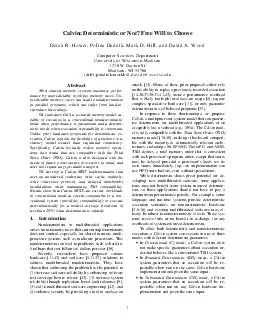PDF-Calvin Deterministic or Not Free Will to Choose Derek R
Author : karlyn-bohler | Published Date : 2014-12-14
Hower Polina Dudnik Mark D Hill and Da vid A Wood Computer Sciences Department University of WisconsinMadison 1210 W Dayton St Madison WI 53706 drh5pdudnikmarkhilldavidcswiscedu
Presentation Embed Code
Download Presentation
Download Presentation The PPT/PDF document "Calvin Deterministic or Not Free Will to..." is the property of its rightful owner. Permission is granted to download and print the materials on this website for personal, non-commercial use only, and to display it on your personal computer provided you do not modify the materials and that you retain all copyright notices contained in the materials. By downloading content from our website, you accept the terms of this agreement.
Calvin Deterministic or Not Free Will to Choose Derek R: Transcript
Download Rules Of Document
"Calvin Deterministic or Not Free Will to Choose Derek R"The content belongs to its owner. You may download and print it for personal use, without modification, and keep all copyright notices. By downloading, you agree to these terms.
Related Documents














